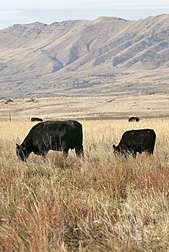Finding new forages for rangeland cattle

(PhysOrg.com) -- Cattle that graze on rangelands in the western United States may soon have a new forage option, thanks to work by a U.S. Department of Agriculture (USDA) scientist.
Research by geneticist Blair Waldron with USDA's Agricultural Research Service (ARS) in Logan, Utah, suggests that forage kochia (Kochia prostrata) can provide more nutritious winter forage than traditional rangeland vegetation.
ARS is USDA's chief intramural scientific research agency, and this work supports the USDA priorities of responding to climate change and promoting international food security.
Waldron and his cooperators in Utah partnered to learn more about forage kochia, a shrubby Asian native plant that sometimes survives wildfires and other environmental challenges more successfully than North American native plants. Waldron works at the ARS Forage and Range Research Laboratory in Logan.
In a series of studies, the team found that forage kochia can be established on damaged rangelands, and that it can compete with cheatgrass successfully. It can even protect against wildfires.
Waldron and his research partners also investigated fall/winter rangeland forage yields, rangeland carrying capacities, nutritive values, and the livestock performance of cattle that spent the fall and winter grazing on either kochia-dominated rangelands or grass-dominated rangelands. The team stocked each site with predominately Black Angus cattle and ran field trials for two seasons.
They found that the forage yield on rangelands seeded with kochia was 2,309 pounds per acre, which was six times greater than the forage yield on traditional grazinglands. This difference meant that the rangelands with kochia could support 1.38 animals per acre, while the traditional rangelands could support only 0.24 animal per acre.
In addition, the experimental forage had a crude protein content of 11.7 percent, well above the recommended minimum, while the stockpiled grasses had a crude protein content of only 3.1 percent, which was below the recommended minimum.
Results from this research were published in Forage and Grazinglands, Journal of Extension, Small Ruminant Research, and elsewhere.
Provided by USDA Agricultural Research Service

















